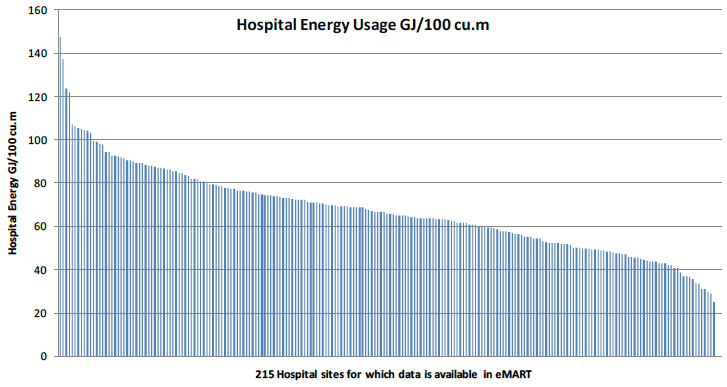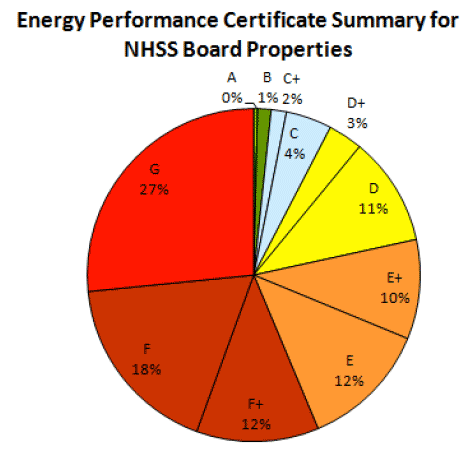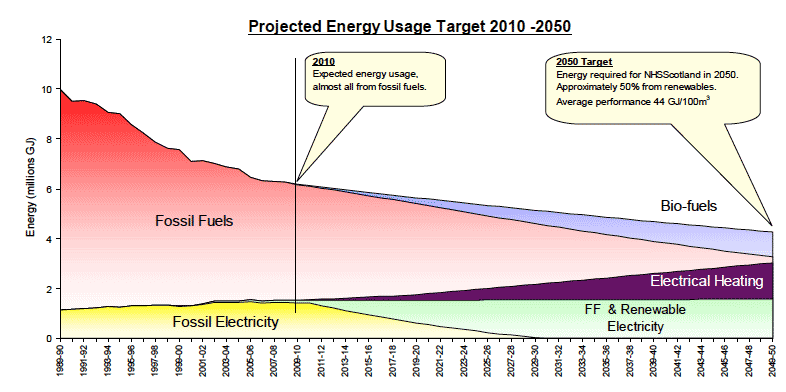State of the NHSScotland Estate 2011
A review of asset management performance in NHSScotland, identifying the current state of the estate, highlighting areas of best practice and areas for improvement.
4.0 Sustainability
4.1 Context
The sustainability and environmental performance of NHSScotland as a major public sector body is coming under increasing scrutiny at the present time for a number of reasons:
- Sustainable Economic Growth is at the core of the Scottish Government's Purpose and Economic Strategy. The Scottish Government has set a High Level Target on Sustainability in the National Performance Framework, supported by 15 national outcomes.
- Good environmental performance contributes to the achievement of a number of these national outcomes, in particular:
- Outcome 10 We live in well-designed, sustainable places where we are able to access the amenities and services we need;
- Outcome 12 We value and enjoy our built and natural environment and protect it and enhance it for future generations;
- Outcome 14 We reduce the local and global environmental impact of our consumption and production; and
- Outcome 15 Our public services are high quality, continually improving, efficient and responsive to people's needs.
- The Climate Change (Scotland) Act 2009 set ambitious targets for emissions reductions. Section 44 of the Act places a duty on public bodies, in exercising their functions, to act in:
- the way best calculated to contribute to the delivery of the Act's emissions reduction targets;
- the way best calculated to deliver any statutory adaptation programme; and
- a way that they consider most sustainable.
- Section 76 of the Act requires Ministers to report annually on progress towards improving the contribution to sustainability of buildings that are part of the civil estate in Scotland.
- Using resources more efficiently can contribute to delivering the efficiencies and savings needed to tackle public spending constraints.
- There is heightened public awareness of sustainability/Greener issues generally.
The Scottish Government has stated strongly its ambition to be an exemplar on sustainability and lead by example on the issue of environmental performance. Specifically, the sustainability of Scotland's NHS has strategic relevance to population health. The scale and diversity of NHSScotland operations and, by extension, it's ecological and carbon footprint, can significantly influence its impact on the environment and on the health of Scotland's population and, to an extent, wider.
These policies place health and wellbeing and the over-arching issue of sustainability at the centre of the lives of the people of Scotland as the NHS strives to become more accountable and patient-focused. If the commitment to create a healthier, wealthier, fairer, safer and stronger Scotland is to be realised, NHS Boards must ensure that their commitment to the provision of healthcare services and the day-to-day operation of these services will realise benefits for community development and the wider environment as well as public health.
The day to day operation of hospitals and other, smaller, healthcare facilities and the functional linkage with the wider NHS service delivery family has a direct impact on the environment. Decisions taken on the development and redevelopment of land and buildings can have particular implications for land use planning, transport and biodiversity. As NHSScotland is directly concerned with improving the health of the population and the provision of healthcare, it is vitally important that it is at the forefront of improving environmental performance, reducing any harmful impact on the environment and providing an exemplar environmental model to the rest of the community.
4.2 Policy
The Policy on Sustainable Development for NHSScotland (CEL 2 (2012)) and the accompanying 2012 revision of the Sustainable Development Strategy for NHSScotland will, together with NHS Board-specific Sustainable Development Action Plans, form the framework for the achievement of the Scottish Government's sustainable development objectives. The scope / remit of the Policy and supporting Strategy is primarily in the context of estates / property and asset management to:
- Ensure a holistic approach to the implementation of all Scottish Government policies impacting on the sustainability of Scotland's NHS
- Ensure that all NHSScotland Bodies, as an integral part of the commitment to the health and well being of the community, ensure that their activities are consistent with Best Value legislation which places a duty on the public sector to contribute to the achievement of sustainable development
- Ensure that NHSScotland Bodies strive to continually improve their performance in sustainable development from an established baseline, such as determined by the self-assessment process through use of the Good Corporate Citizenship Assessment Model (GCCAM) toolkit, mandated via CEL 14 (2010) and, by other relevant reporting as necessary.
The Policy for Property and Asset Management for NHSScotland requires that NHS Boards report on environmental performance, particularly the Scottish Government HEAT Target E8 on energy consumption reduction and carbon emissions reduction for NHS Boards for 2009-2010 (see below), and on an analysis of performance in relation to the absolute and weather-corrected variances and Key Performance Indicators produced through the Health Facilities Scotland (HFS) Environmental Monitoring and Reporting Tool (eMART) across the four main parameters of CO2, energy, water and, waste.
4.3 Targets and KPIs
The first phase of the HEAT Target E8 to reduce energy consumption by 2% per year came to an end in 2009 - 10 and a new HEAT target (Phase 2) came into operation from April 2010. The Annual National Environment Report will report on these new targets for 2010 - 11.
The Phase 2 HEAT target has been designed to achieve two aims. Firstly, it is set at a level to ensure that NHSScotland achieves the 2050 CO2 target as set in the Climate Change (Scotland) Act 2009 and secondly to continue to improve the efficiency in the way energy is used.
To meet these two objectives, the following two-part target began in April 2010:
- CO2 emissions reduction target of 3% year-on-year on all fossil fuel use, i.e. oil, gas, butane and propane usage, designed to eliminate the use of fossil fuels by 2050.
- A year-on-year energy efficiency target of 1%, based on an overall improvement by 2050 of one third on the comparative performance as at 2009-10. This would be equivalent to achieving a reduction in the all-Scotland average consumption from the current 63GJ/100 m3 to an average 44GJ/100m3.
- The baseline year for the two targets is the final outturn of 2009 - 10.
- Phase 2 commences in 2010 - 11 and runs until 2014 - 15, a five year campaign.
- The targets will be re-assessed every 5 years and amended where necessary to ensure the Climate Change Act 2050 targets are achieved.
Setting these two targets on a year-on-year basis will also ensure a greater portion of improvement within the early years of implementation.
Both the E8 energy efficiency and CO2 targets are designed not only to achieve the Climate Change Act target but also to ensure that NHSScotland continues to lead by example within the public sector.
The CO2 target is aimed at the fundamental change needed to move away from the use of fossil fuels. This will involve replacement of gas and oil heating systems with alternative renewable energy sources, including the wider introduction of biomass heating plants, heat pumps and other low/non-carbon heating technologies that become readily available in the market over the next forty years.
4.4 Reporting tools
To facilitate the collection of energy consumption, carbon emissions, water and waste data throughout the NHS estate, Health Facilities Scotland (HFS) provides and maintains a national reporting system, commonly known as the Environmental Monitoring and Reporting Tool (eMART). This allows all NHS Boards in Scotland to submit their data returns through a standardise communal system which allows users to set targets at individual building level and can automatically analyse performance against these targets. The data output from the system is also used to provide performance measures against the national HEAT target to reduce carbon emissions and continue energy efficiencies which are published through Scotland Performs and through the Annual NHSScotland National Environment Report, published by HFS. The Scottish Government have agreed that eMART should be the preferred data collection tool for reporting requirements in relation to Section 76 of the Climate Change (Scotland) Act 2009.
The NHSScotland National Environment Report describes NHSScotland's environmental performance for each financial year. It tracks progress against national targets with both absolute values and trends measured over up to 21 years. Data for each NHS Board is provided on energy, water, wastewater and waste.
4.5 Energy performance
The Annual National Environment Report has consistently shown that NHSScotland has a good track record of reducing energy consumption year on year. The 2009/10 report shows that the cumulative reduction in energy consumption for the 24 years since 1985 - 86 is now 44%. For the period 2010/11, energy consumption reduced by 3.48% and CO2 emissions by 4.58% against the base year 2009/10.
Comparative energy performance has in the past been measured using both a comparative performance indicator (CPI) and a key performance indicator (GJ per 100 cu.m per year). The use of the CPI is currently being reviewed and therefore, the current preferred comparator for energy consumption is GJ per 100 cu.m per year. This measure is well established from Estatecode which categorises buildings as follows:
| GJ/100 cu.m | Estatecode Category | Performance |
|---|---|---|
| 35-55 | A | Excellent |
| 56-65 | B | Good |
| 66-75 | C | Could be improved |
| 76-100 | D | Poor |
The NHSScotland 2009/10 Environment Report provides the following information in relation to energy usage per 100 cu.m.
| NHS Board | GJ/100 cu.m |
|---|---|
| NHS Shetland | 51 |
| NHS Tayside | 53 |
| NHS Lothian | 56 |
| NHS Lanarkshire | 59 |
| NHS Greater Glasgow and Clyde | 66 |
| NHS Western Isles | 66 |
| NHS Highland | 67 |
| NHS Fife | 67 |
| NHS Borders | 69 |
| NHS Grampian | 70 |
| NHS Ayrshire and Arran | 70 |
| NHS Dumfries and Galloway | 73 |
| Golden Jubilee National Hospital | 76 |
| The State Hospital | 76 |
| NHS Forth Valley | 77 |
| NHS Orkney | 83 |
Note: Based on Hospital only fuels - does not include whole site energy use
Analysis of the raw eMart data for individual buildings identified a range of energy usage from 147 GJ/100 cu.m to 25 GJ/100 cu.m as shown in the chart that follows. This analysis also identified that 110 of the 215 sites have hospital energy consumption greater than 65 GJ/100 cu.m i.e. relatively poor energy performance.

The table that follows summarises the Energy Performance Certificates (EPCs) for buildings in each of the NHS Boards. This shows that the majority of buildings are rated at the 'poor' end of the EPC ratings (E,F, G).

However, energy performance certificates are an indication of carbon dioxide ratings compared with the original design standards and benchmarked against current building standards to identify improvements. Reasons why a significant proportion of NHS buildings has poor ratings include:
- The age of the estate. 35% is over 50 years old and 65% is over 30 years old. This means that the original design standards are not readily available for comparison and the worst case default is applied driving the rating down. The age also makes it difficult to comply with the regulatory requirements applied.
- The certificates focus on carbon emissions which do not give a true reflection of energy performance as they automatically rate energy sources such as oil and electricity as very low. Most of the properties identified with poor ratings use electricity from the grid or oil due to their remote locations.
Poor energy performance certificate ratings do not indicate higher energy costs as these are an indication of carbon emissions not energy use and carbon emissions are dependent on the energy source used.
Scottish Government and NHSScotland has a number of initiatives to reduce carbon emissions. The Scottish Government 2020 routemap for renewable energy in Scotland identifies plans to decarbonise the electricity grid by increasing supplies from renewable energy which will improve the ratings for all properties attached to the grid. NHSScotland has a strategy to reduce carbon emissions through:
- Investment in low carbon buildings
- Continued reduction in fossil fuel use
- Investment in low carbon heating systems, appropriate renewables and energy efficiency measures
- Reduction in size of the estate.
Current UK energy target in healthcare design is 35 - 55GJ/100 cu.m /year. For the period 2010-15, NHSScotland has introduced a target which requires a 3% year on year fossil fuel CO2 emission reduction and a 1% year on year energy efficiency improvement. The target is aligned with Scottish Government targets, and is to improve the NHSScotland average performance to 44 GJ/100 cu.m/year.
4.6 Energy usage
The chart that follows shows the projected change in energy usage required over the next 40 years as fossil fuels are replaced with alternative energy supplies from suppliers and some on site sources to meet the 2050 target.

Studies in the UK and Europe and confirmed by eMART show that in "Hospitals and Clinics" energy use follows well defined patterns; a high steady base load and daily variation peaking at around lunchtime. This is almost certainly because it is not the end-use of energy, but the need to control the individual environments that is the dominant requirement. The studies suggest that fuel is mainly used for comfort heating and to produce hot water, and electricity is primarily used for lighting, ventilation fan motors and water circulation motors. Together these uses typically account for 75% of a hospital's total energy use and energy cost.
4.7 Efficiency plans
In order to reduce the baseline energy of hospitals and clinics there needs to be a focus on:
- Investment in buildings with improved energy performance i.e. high insulating materials and use of passive design techniques
- Improving the performance of building services systems i.e. controls, building management systems and zone controls
- Use of new and innovative energy technologies such as occupancy detectors, variable speed pumps and fans
- Reducing the size of the estate
Annex B "Summary of the NHS Boards priorities and focus for the next 5 years" shows that a number of energy and environmental efficiency schemes are included in the NHS Board's PAMS.
4.8 Carbon dioxide emissions
After increases in CO2 emissions in both 2007 - 08 and 2008 - 09 years, emissions fell in 2009 - 10 by 3,442 tonnes to 410,057 tonnes(-0.83%). All emission savings were achieved from a reduction in fossil fuel use. Emissions associated from the use of grid-supplied electricity increased by more than 2,226 tonnes. With the number of degree days in 2009 - 10 almost the same as the previous year, there was very little adjustment for weather correction. CO2 emissions since 1989/90 now stand at a reduction of 41.42%. Over this same 20 year period, absolute energy usage has reduced by 39.85%.
4.9 Water consumption and costs
During 2009 /10, water consumption dropped for a third successive year by 0.51%; with a total recorded use of 5.27 million cubic metres. The cost of water was also down 5.30% to £4.23m, reflecting the fall in usage even though unit costs increased by approximately 3%.
4.10 Liquid waste discharged and costs
Total liquid discharged to the public sewerage system, made up of both trade effluent and wastewater, was reduced by 7.87%. The total cost for liquid discharged to the public sewerage system increased by 2.27% to £5.10m, due to a rise in costs.
4.11 Clinical and non-clinical waste and costs
The amount of clinical waste produced in 2009/10 decreased for the first time in 6 years to a total of 14,850 tonnes, this equates to a decrease of approximately 2.48% in volumetric terms.
The amount of non-clinical waste produced in 2009/10, including all categories of recycled waste, fell by 3.84% compared to the previous year. Also during this period, the third year of collecting data on recycled waste, the amount recycled increased from 2,641 to 2,955 tonnes equating to an increase of approximately 11.8%.
The cost for the treatment and disposal of all waste fell substantially to £8.77m, down 14.43% in comparison with the previous year. The average cost per tonne for the disposal of clinical waste dropped almost 23.05% to £385.62 per tonne while the cost per tonne for non-clinical increased by 20.96% to £115.64 per tonne.
Contact
Email: James H White
There is a problem
Thanks for your feedback